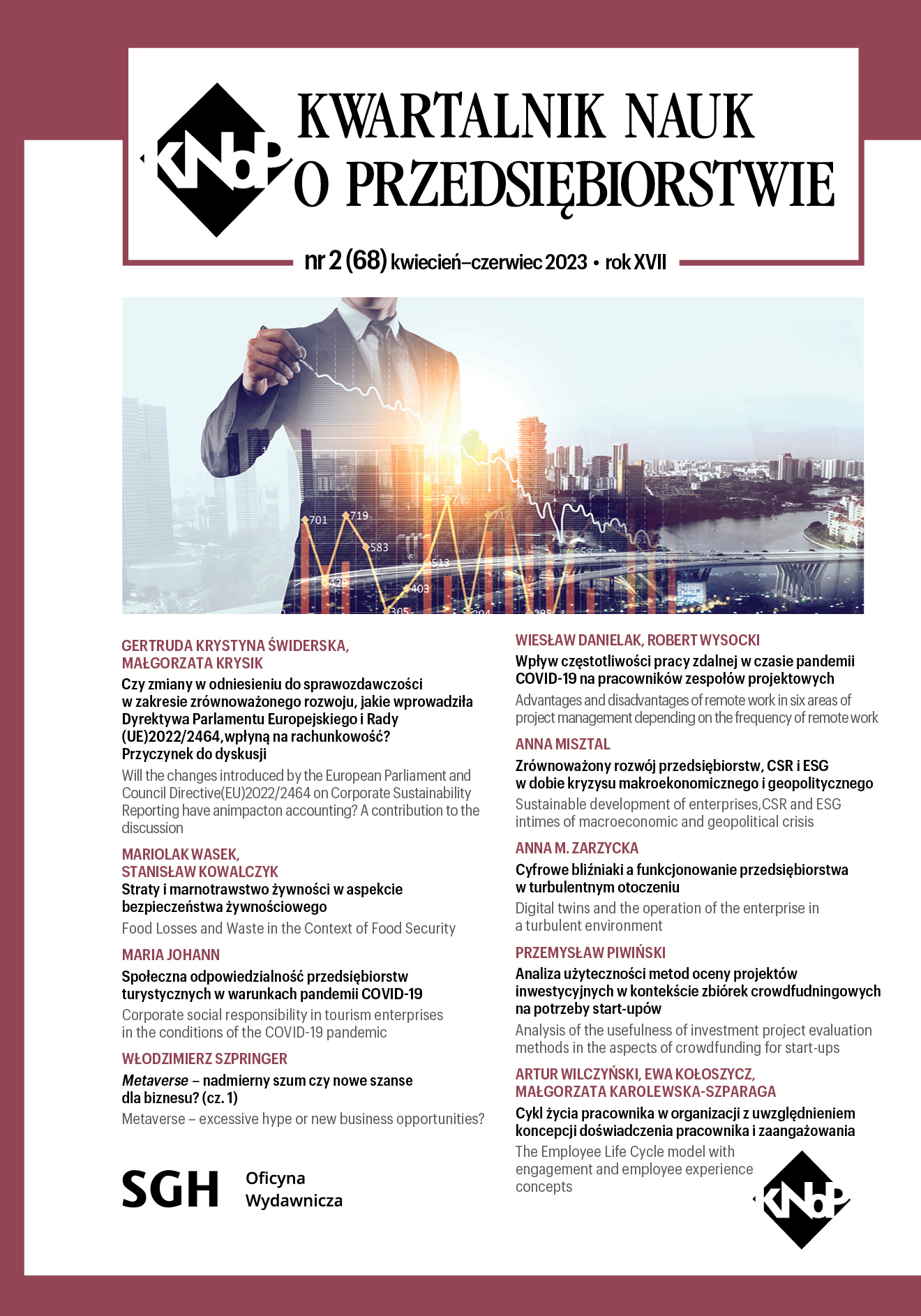The Employee Life Cycle model with engagement and employee experience concepts
Main Article Content
Abstract
The model of the employee life cycle in an organization has an important position in human resource management activities. The study includes a definition of the employee life cycle with concepts that stand out from those most often described in human resource management studies. Fundamental to the research value of this study are touchpoints between the organisation and the employee that build the employee experience. Their analysis has allowed the definition and characterisation of a six-stage model of the employee life cycle in an organisation. The model prepared was related to the concept of building employee engagement. An authorial linkage was made between resource management duties and responsibilities and ways of building employee engagement. The development of the presented concept of the employee life cycle in an organisation was the construction of a best practices used in employee management processes with Key Performance Indicators. Consequently, the responsibility of the actors of the human resource management system for the right course of the employee life cycle was indicated. It was concluded that the involvement of top management, line managers and employees with the support of human resource managers results in no shortening of the employee life cycle or reduces the inappropriate phases. This is critically important from an organisational management, as it provides high employee retention and allows for accurate management of employee performance.
Downloads
Article Details

This work is licensed under a Creative Commons Attribution 4.0 International License.
The author of the article declares that the submitted article does not infringe the copyrights of third parties. The author agrees to subject the article to the review procedure and to make editorial changes. The author transfers, free of charge, to SGH Publishing House the author's economic rights to the work in the fields of exploitation listed in the Article 50 of the Act of 4 February 1994 on Copyright and Related Rights – provided that the work has been accepted for publication and published.
SGH Publishing House holds economic copyrights to all content of the journal. Placing the text of the article in a repository, on the author's home page or on any other page is allowed as long as it does not involve obtaining economic benefits, and the text will be provided with source information (including the title, year, number and internet address of the journal).
References
App S., Merk J., Buettgen M. (2012), Employer Branding: Sustainable HRM as a Competitive
Advantage in the Market for High-Quality Employees, „Management Revue. The International Review of Management Studies”, Vol. 23, No. 3, pp. 262–278.
Arnold J., Van Iddekinge C., Campion M., Bauer T., Campion M. (2020), Welcome Back? Job Performance and Turnover of Boomerang Employees Compared to Internal and External Hires. „Journal of Management”, Vol. 47, No. 8, pp. 2198–2225.
Başaran R. (2021), Employee Experience Management, in: Connect with Your Management On-The-Go, M. Naci Efe (ed.) Peter Lang.
Bauer T. (2010), Onboarding New Employees: Maximizing Success, SHRM Foundation’s Effective Practice Guidelines, https://www.shrm.org/foundation/ourwork/initiatives/resources-frompast- initiatives/Documents/Onboarding%20New%20Employees.pdf (dostęp: 18.12.2022).
Becker K., Bish A. (2021), A framework for understanding the role of unlearning in onboarding, „Human Resource Management Review”, Vol. 31, No. 1, pp. 100–730).
Burke M., Six Stages to Success with the Employee Lifecycle, https://inside.6q.io/six-stages-tosuccess- with-the-employee-lifecycle/ (dostęp: 20.12.2022).
Prajapati G., Pandey S. (2020). Enhancing Employee Experience during Covid-19: A Qualitative
Study on Investment Banks. „International Journal of Modern Agriculture”, Vol. 9, No. 3, pp. 1711–1734.
Cattermole G., Engagement lifecycle, https://www.trainingjournal.com/articles/feature/engagement-lifecycle (dostęp: 16.12.2022).
Gilani H., Cunningham L. (2017), Employer branding and its influence on employee retention: A literature review, „The Marketing Review”, Vol. 17, No. 2, pp. 239–256.
Gladka O., Fedorova V., Dohadailo Y. (2022), Development of conceptual bases of the employee lif ”e cycle within an organization, „Theory and Practice”, Vol. 23, No. 1, pp. 39–52).
Heinle A., Employee Life Cycle: 7 Stages (+The Metrics That Matter). https://www.zavvy.io/blog/employee-life-cycle (dostęp: 12.12.2022).
Kakade, S. Employee life cycle. https://www.techtarget.com/searchhrsoftware/definition/employeelife-cycle (dostęp: 12.12.2022).
Keller J., Kehoe R., Bidwell M., Collings D.,Myer, A. (2021), In With the Old? Examining When Boomerang Employees Outperform New Hires. „Academy of Management Journal, Vol. 64, No. 6, pp. 1654–1684.
Lupfer E. The Employee Lifecycle is Your Roadmap to Building an Engaged Employee Experience. https://thesocialworkplace.com/2017/11/the-employee-lifecycle-is-your-roadmap-tobuilding-an-engaged-employee-experience/ (dostęp: 20.12.2022).
Malik A., Budhwar P., Mohan H., Srikanth N. (2022), Employee experience –the missing link for engaging employees: Insights from an MNE’s AI-based HR ecosystem. „Human Resource Management”, Vol. 62, No. 1, pp. 97–115.
Nafei W. (2014), The Role of Organizational DNA in Improving Organizational Performance: A Study on the Industrial Companies in Egypt. „In International Business Research”, Vol. 8, No. 1, pp. 117–131.
Nagendra A. (2014), Paradigm Shift in HR Practices on Employee Life Cycle Due to Influence of Social Media, „Procedia Economics and Finance”, Vol. 11, pp. 197–207.
Panneerselvam S., Balaraman K. (2022), Employee experience: the new employee value proposition, Strategic HR Review, Vol. 21 No. 6, pp. 201–207.
Plaskoff, J. (2017). Employee experience: the new human resource management approach. „Strategic HR Review”, Vol. 16, No. 3, pp. 136–141.
Raveendra P., Satish M. (2022), Boomerang hiring: Strategy for sustainable development in COVID-19 era, „Human Systems Management”, Vol. 41, No. 2, pp. 277–282.
Verive J., DeLay N. (2006), Measuring telework ROI: Metrics based on the employee life cycle, „World at Work Journal”, Vol. 15, No. 2, pp. 6–15.
Verlinden, N., Employee Life Cycle: The Ultimate Guide for HR. https://www.aihr.com/blog/employee-life-cycle/ (dostęp: 20.12.2022).

